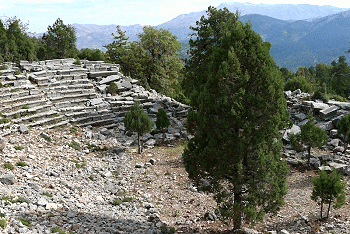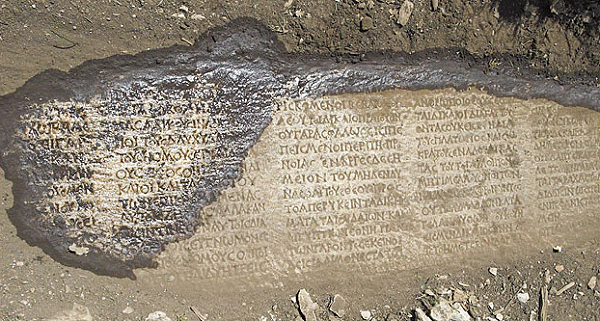
Oinoanda Didrachms were an unusual denomination
Oinoanda Didrachms by Russell A. Augustin, AU Capital Management, LLC ……
Oinoanda, an ancient Greek city located in the upper valley of the Xanthus River, was built on the top of a high mountain in the ancient province of Lycia, now modern southwest Turkey. Little is known of the early history of the settlement in spite of several exploratory surveys which have been carried out in the region.
It was a substantial city in antiquity, but surprisingly it issued its own silver coins at only one moment in its long history. Until the early 2000s, the coinage was known from only a single specimen acquired by the British Museum in 1897. The discovery of a small group has allowed the types to be studied in much more detail and has added to our admittedly sparse understanding of the coins of the period.
 Three distinct issues have been identified, marked by a sequence of letters and symbols. They are dated to the first three years of Attalid rule of the region, which followed the Peace of Apameia in 188 BCE after the Roman defeat of Antiochos III in 190 BCE. The terms of the peace dictated that much of the Seleukid territory in Anatolia passed to the control of Pergamon and Rhodes. Photo Caption – The Greco-Roman theatre in Oenoanda [ Οινόανδα (Greek) ]
Three distinct issues have been identified, marked by a sequence of letters and symbols. They are dated to the first three years of Attalid rule of the region, which followed the Peace of Apameia in 188 BCE after the Roman defeat of Antiochos III in 190 BCE. The terms of the peace dictated that much of the Seleukid territory in Anatolia passed to the control of Pergamon and Rhodes. Photo Caption – The Greco-Roman theatre in Oenoanda [ Οινόανδα (Greek) ]
Because of this, Oinoanda was able to establish sufficient autonomy to begin to mint its own coinage. It is apparently due to the wide variety in coin weight that the mint did not have experience in quality control, but each of the coins was intended to be an Attic didrachm, weighing about 8.65 grams.
Contrary to the very prevalent drachm and tetradrachms in the region, didrachms were an unusual denomination. It has been theorized that this weight was chosen for streamlined exchange between the Attic standard and the new cistophoroi of the Attalids, with three Oinoandan didrachms equaling two cistophoric tetradrachms.
With both cistophoric and Attic coinages being used in Oinoanda, the Oinoanda didrachm would make it easier to handle official payments to the Attalid authorities and trade with local and nearby territories still on the Attic standard.
The underlying purpose for this rare and isolated coinage is still unclear, but it may have been minted to pay for the Hellenistic city walls built during the period after the formal Attalid takeover. However, the four known obverse dies would have produced a substantially insufficient quantity of coins to pay for such a large undertaking, indicating that unless coins from more dies are discovered in the future, the difference may have been funded by the cistophoroi or Side tetradrachms which circulated in the region.
Zeus was the principal deity of Oinoanda, and he is depicted on the obverse of this coin with a lotus-tipped scepter over his shoulder. His eagle is shown on the reverse, standing to the right on a winged thunderbolt. The design appears to have been influenced in part by the Ptolemaic Kingdom of Egypt, sharing similar attributes, but clearly deviating in actual execution.
This coin is the finest of only four known from the first die pair in the series, marking it as one of the first coins struck by Oinoanda and placing it at the beginning of an enigmatic and aesthetic coinage that historians are still learning from today.
LYCIA, Oinoanda. 188 BCE. AR Didrachm (19mm, 7.92 g, 12h). Laureate head of Zeus right; A and scepter behind / Eagle standing right on winged thunderbolt. Ashton, Oinoanda 1 (A1/P1), otherwise unpublished. EF, dark iridescent toning. Well-centered and sharply struck from the first die pairing of the series. Extremely rare and the finest of the four known from these dies.

The Oinoanda Inscription (fragment pictured) was an inscribed limestone wall conspicuously located in an open marketplace generally referred to as the “Esplanade” in the ancient city of Oinoanda. The inscription, commissioned by Diogenes of Oinoanda, proclaimed the wisdom of Epicurus, then deceased for five centuries. This unique text, rediscovered in the late nineteenth century, has attracted many modern readers. The wall itself, however, has long been demolished. Its blocks were used for building houses, paving streets, etc. They were discovered one by one.




